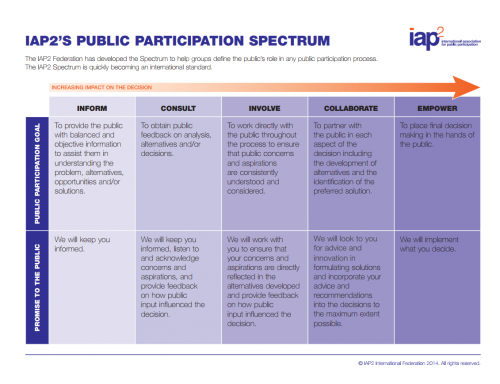Engaging the public in local government decisions: Collaborate
How can government better engage the public in decision-making processes?
If you’re an elected (or appointed) official, have you ever wondered if there was a better way to engage the public in local government than having them observe and maybe give public comment at an open meeting? If you are a private citizen, have you ever wished you could be more involved in the government/decision making process? The International Association of Public Participation (IAP2) has developed a spectrum that outlines various levels of public engagement, and provides a framework for those in government who are planning public participation processes.
This is the next article in a series of Michigan State University Extension articles that examine the public’s participation in local government. The series began by discussing public comment periods at open meetings, which you can find here. Other articles introduced the IAP2 Public Participation Spectrum and discussed the steps of Inform, Consult and Involve. Each step on the spectrum can be viewed as a commitment to a level of public participation. Each step includes a goal for public participation, and a promise that the governmental body is making to the public regarding the level of participation that may indeed contribute to the decisions that that will be made.
This article will take a closer look at the fourth step on the Public Participation Spectrum: Collaborate. In collaborate, the goal is “to partner with the public in each aspect of the decision including the development of alternatives and the identification of the preferred solution.” The promise is to seek advice from the public and innovation in forming solutions to a problem, and incorporate public advice and recommendations into the decision to the greatest extent possible.

Collaborate sets a high bar because it demands an interactive process with cooperation between the government unit and the public. The final decision-making authority ultimately still rests with the government unit, but to meet the promise of collaborate, the public needs to be deeply involved in developing and choosing a solution to a problem.
Involving the public to this degree often requires an attempt to form consensus on the issue at hand. This requires another clarification, as there are many ideas about what consensus may mean and what level of consensus should be sought. The level of consensus being pursued in a process should be clearly defined and in the collaboration step, the public should have some role in defining that.
As with Involve, but to an even greater extent, the public should also be involved in the design of the process. Governments seeking to improve their public engagement should be continuously seeking feedback on how the process can be improved to ensure that audiences that are traditionally not part of the process (either by choice or because efforts are not made to engage them intentionally) are able to engage.
Collaboration level engagement can be difficult, time consuming, and resource intensive. There also exists the possibility of harming relationships and breaking trust with the public, if the decision-making body does not live up to the promise in Collaborate or if consensus cannot be reached.
That said, a well-designed, intentionally inclusive collaboration effort can have far-reaching benefits of building trust and identifying innovative solutions that otherwise might have been missed. This leads to decisions that truly reflect the needs and desires of the community.
The next article in this series will look at the next level on the public participation spectrum: Empower.
Those in Michigan State University Extension that focus on Government and Public Policy provide various training programs, which are available to be presented in your county. Contact your local Government and Public Policy educator for more information.



 Print
Print Email
Email